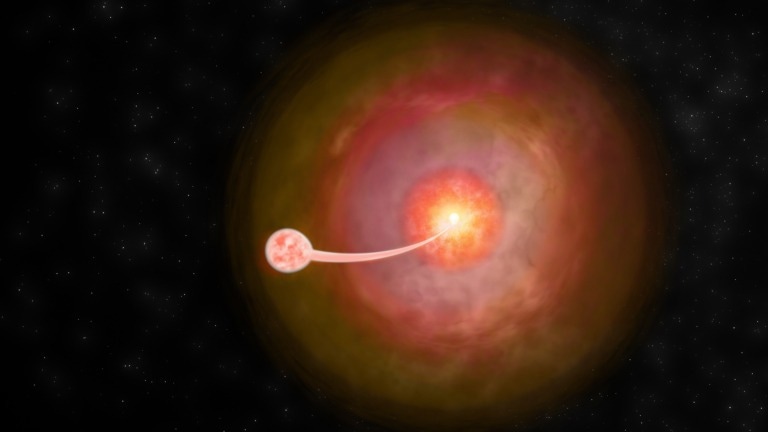Using the Very Long Baseline Array (VLBA) of the National Radio Astronomy Observatory to analyze classical novae, a graduate student found evidence that the objects may have been mistakenly typecast as simple.

This artist’s conception depicts V1674 Herculis, a classical nova hosted in a binary star system that is made up of a white dwarf and dwarf companion star. Scientists studying this nova have detected non-thermal emission, a departure from the historical belief that these systems produce only thermal emissions. Image Credit: B. Saxton (NRAO/AUI/NSF)
At a press briefing conducted on June 6th, 2023, the new observations—which discovered non-thermal emission from a classical nova with a dwarf companion—were revealed. The proceedings of the 242nd American Astronomical Society are being held in Albuquerque, New Mexico.
The fastest known classical nova is V1674 Herculis, which is hosted by a white dwarf and a companion dwarf. Montana Williams, a Ph.D. student at New Mexico Tech who is in charge of the examination into the VLBA characteristics of this nova, confirmed the unexpected: non-thermal emission coming from it.
This information is crucial because it provides Williams and her colleagues with a wealth of information about what is occurring in the system. The team’s findings go well beyond the simple heat-induced explosions that scientists had previously anticipated from classical novae.
Classical novae have historically been considered simple explosions, emitting mostly thermal energy. However, based on recent observations with the Fermi Large Area Telescope, this simple model is not entirely correct. Instead, it seems they’re a bit more complicated. Using the VLBA, we were able to get a very detailed picture of one of the main complications, the non-thermal emission.
Montana Williams, Study Lead and Graduate Student, New Mexico Tech
It is rare to find detections of classical novae with dwarf companions like V1674Her using very long baseline interferometry (VLBI). They are so uncommon that there has only ever been one other report of this particular sort of detection with resolved radio synchrotron components. This is partially due to the presumptive character of classical novae.
Williams added, “VLBI detections of novae are only recently becoming possible because of improvements to VLBI techniques, most notably the sensitivity of the instruments and the increasing bandwidth or the amount of frequencies we can record at a given time. Additionally, because of the previous theory of classical novae they weren’t thought to be ideal targets for VLBI studies. We now know this isn’t true because of multi-wavelength observations which indicate a more complex scenario.”
The team’s new discoveries are significant because of their rarity since they let us learn more about the secret lives of classical novae and the factors that eventually cause their explosive behavior.
Williams further stated, “By studying images from the VLBA and comparing them to other observations from the Very Large Array (VLA), Fermi-LAT, NuSTAR, and NASA-Swift, we can determine what might be the cause of the emission and also make adjustments to the previous simple model. Right now, we are trying to determine if the non-thermal energy is coming from clumps of gas running into other clumped gas which produces shocks, or something else.”
The classical nova was a perfect target for investigation since Fermi-LAT and NuSTAR measurements had already shown that V1674Her would be emitting non-thermal emissions, and Williams and her colleagues are trying to confirm or refute these types of discoveries.
Due to its incredibly quick evolution and the fact that, unlike supernovae, the host system isn't destroyed during it and instead stays nearly entirely undamaged after the explosion.
She added, “Many astronomical sources don’t change much over the course of a year or even 100 years. But this nova got 10,000 times brighter in a single day, then faded back to its normal state in just about 100 days. “Because the host systems of classical novae remain intact, they can be recurrent, which means we might see this one erupts, or cutely explode, again and again, giving us more opportunities to understand why and how it does.”
The National Radio Astronomy Observatory (NRAO) is a key facility of the National Science Foundation (NSF) that is maintained by Associated Universities, Inc. under a cooperative agreement.